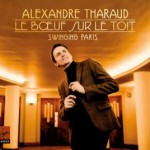by Sedgwick Clark
December is a special time for us at Musical America because we have the great pleasure of honoring a group of the finest musicians in the world and introducing the latest issue of our annual Directory. At our Awards party Joy to the World reigns, we forget about our typos, gnashing of teeth over cancelled bookings, dried up press outlets, and orchestra deficits.
Last night (Thursday, December 6) was no exception. Our five 2013 awardees were eloquent and humble in their expression of the art to which they have committed their lives. They are:
Musician of the Year: Gustavo Dudamel
Composer of the Year: David Lang
Instrumentalist of the Year: Wu Man
Vocalist of the Year: Joyce DiDonato
Educator of the Year: José Antonio Abreu
As always on this favorite annual night of my professional life, I felt honored in being able to present the awards to such incredibly musical artists who have made my distinctly unmusical but appreciative life such an immense pleasure night after night in New York’s concert halls for the past 44 years. I don’t mean to slight the first four of the artists above when I say that I had an extraordinary reaction when Maestro Abreu arrived with his large family and associates. We shook hands and he smiled and spoke warmly of how pleased he was to be here, and I just lost it. To be in the same room as the conductor and teacher hailed as creator of the most imaginative approach to music education in our time was simply overwhelming. I sputtered a few ridiculous words of our pleasure to have him here and had to turn away. Thinking about my reaction, the only word I have been able to come up with to describe him is “saintly,” a word that astonishes me I could utter.
Oh, well . . . .
The very first issue of the Musical America International Directory of the Performing Arts in 1961 hailed a single Musician of the Year on our cover, Leonard Bernstein. In 1992, the number of artists was increased to include a Composer of the Year, a Conductor, an Instrumentalist, and a Vocalist. The thinking was—rightly so—that there are so many extraordinary musicians deserving of recognition that we should widen the field. Since then, awards have gone to Ensembles, Educators, Collaborative Pianists, and an Impresario as well.
Years ago, the late Audrey Michaels called to tell me that bookings of one of her clients, the violinist Cho-Liang Lin, had increased noticeably after being named Instrumentalist of the Year (2000). Nothing has made my time at Musical America more satisfying.
Looking Forward
My week’s scheduled concerts (8:00 p.m. unless otherwise noted):
12/7 Carnegie Hall. Venezuelan Brass Ensemble/Thomas Clamor.
12/8 Zankel Hall at 1:00. El Sistema lecture and panel. Leon Botstein (keynote lecture), José Antonio Abreu, Gustavo Dudamel (panelists), Jeremy Geffen (moderator).
12/8 BAM Harvey Theater at 7:30. Anonymous 4. David Lang: love fail.
12/9 Juilliard School. Willson Theater at 2 p.m. Juilliard Opera/Mark Shapiro. Britten: Curlew River. Vaughan Williams: Riders to the Sea.
12/10 Carnegie Hall. Simón Bolívar Symphony Orchestra of Venezuela/Gustavo Dudamel. Revueltas: La noche de las Mayas. Chávez: Sinfonía india. Orbón: Tres versiones sinfónicas.
12/11 Carnegie Hall. Simón Bolívar Symphony Orchestra of Venezuela/Gustavo Dudamel; Aquiles Machado, tenor; Gaspar Colón. Baritone; Westminster Symphonic Choir. Esteban Benzecry: “Chaac (Maya Water God)” from Rituales Amerindios. Villa-Lobos: Chôros No. 10. Antonio Estévez: Cantata criolla.
12/12 Symphony Space. Ensemble for the Romantic Century. Jekyll and Hyde. The drama of Dr. Jekyll and his demonic double unfold in a psychoanalytic tale of horror in turn-of-the-century Vienna. Featuring music by Mahler, Schubert, Schumann, Webern, Berg, Zemlinsky, Brahms, Pfitzner, and Schoenberg. Written by Eve Wolf.



Widmann’s Opera Babylon
November 23rd, 2012By ANDREW POWELL
Published: November 23, 2012
MUNICH — Scorpion-Man prowls the rubble of an unnamed flattened city at the start of Babylon, Jörg Widmann’s new opera, wailing as he moves. We should care.
Seven scenes, a Hanging Garden interlude, and three costly theater hours later, he is back, doing his thing over the same debris, also multiplying himself, and alas we have not cared or even learned what he represents. Perhaps he is us sad cityites, predatory and detached from our souls.
Widmann’s librettist for this Bavarian State Opera commission (heard and seen Oct. 31) is the post-humanist philosopher Peter Sloterdijk, whose worries, intra-urban and intra-galactic, drive Babylon in one big circle against the backdrop of the 6th-century-BC Jewish exile.
Sloterdijk’s narrative feebly pivots on a love-interest, in the persons of exile Tammu and local priestess Inanna. The character Soul is catalyst in a progression of these two that ends, before the circle has closed, in a concordance of Heaven and Earth (cue sweet music).
Along the way, Tammu gets drugged, laid, sacrificed, resurrected, and flown away with his gal in a spaceship. After administering the drug and enjoying her man, Inanna’s one job is to descend post-sacrifice into the Underworld and retrieve him, being sure not to lose sight of him as they make their way out together.
If this suggests a too-rich stew of Isolde or Norma and Euridice with Tamino, it is. But we are in Babylon, and your bowl arrives as the Euphrates overflows, the New Year rings in at the Tower of Babel, and Ezekiel dictates the Word of God, not to list the antics of seven Sloterdijk planets and fourteen Poulenc-ish sex organs.
Born here in 1973 and locally esteemed, Widmann as composer is much identified with Wolfgang Rihm, one among several teachers and influences. He is, besides, a bold and expressive clarinetist: a 2012 Salzburg Festival performance of Bartók’s Contrasts with Alexander Janiczek and András Schiff all but vaulted off the Mozarteum’s platform, and a 2011 Munich partnership with the Arcanto Quartet found rare vigor as well as cozy plushness in Brahms’s Clarinet Quintet.
The Nabucco-era subject had taken the composer’s fancy long ago. Ideas sprouted. A raucous Bavarian-Babylonian March emerged as orchestral fruit last year, bridging the millennia if not exactly the cultures. At some point came the link with Sloterdijk and the decision to plough forth with an opera, Widmann’s sixth piece for music-theater.
Undaunted by the librettist’s loony layers, Widmann supplies for Babylon music of chips and shards and sporadic mini-blocks. 160 minutes of it.
He savors direct quotes, splintered just past the point of identifiability. These he takes from jazz, operetta, lute song, Baroque dance, cabaret, Hollywood, symphonies, band repertory. He crafts brief, pleasingly original blocks of sound in various forms — brass swells, percussive glitter, choral refrains, woodwind banter — deploying them to varying effect. He is a gifted colorist, writing with virtuosity for all sections of the orchestra, in this case a large one, heavy on low winds and percussion.
Vocally the writing is less fluent, less confident. Abrupt ascents are a peculiarity. The tessitura of all three principal roles — Inanna, the Soul and Tammu — lies coincidentally high for each of the voice types (two sopranos and a tenor). Vocal lines are often aborted, mid-flight, again producing small blocks.
Widmann’s chipboard elements are arrayed in rapid indigestible sequences some of the time (Scene III’s orgy). Elsewhere, thin writing overstays its welcome or fails to develop in sync with the cosmic-Biblical scheme (Scene V) — the “prolix musical treatment” George Loomis noted in his review.
Enter Carlus Padrissa, the busy Spaniard known for constant stage movement. Hired to define and motivate the opera’s characters and unite the threads in text and score, Padrissa delivers, well, movement.
The gloomy arthropod’s rubble swiftly morphs into moveable letterpress type: Cuneiform, Katakana, Cyrillic, Hebrew — ah, Babel, the universal translator — to be piled up by mummers, piled down, carried off, brought on. Nearly incessantly. Flown and raised platforms support and transport sundry participants, some of them needed. Projected screen-saver lines depict the restless Waters of Babylon. Moving photographic images reveal holy verse, hell fire, a meteor (or ICBM) crashing to Earth. There is always plenty to watch.
Still, two problems dog Padrissa’s circus-like approach to opera, evident in his 2007–9 Valencia Ring and 2011 Munich Turandot: movement everywhere deprives the action of focus; and physical space required for upstage activities (open wings, as in ballet) deprives the singers of sound boards (in the form of sets) to reflect and project their voices. So it is with Babylon.
In the Turandot — due by chance for Internet streaming in its revival on Sunday (Nov. 25), here, and significant for the textual decision to end where Puccini ended — the voice-projection problem is addressed by having much of the principal singing occur drably near the stage apron.
In Babylon it is addressed with amplification*, subtly on the whole, though on Oct. 31 individual vocal lines resounded unnaturally at several moments.
Generalmusikdirektor Kent Nagano brought to the new opera his dual virtues of judicious tempos and attention to balances. The orchestra played compliantly, David Schultheiß working as poised and able concertmaster. Anna Prohaska and Claron McFadden coped deftly with the vocal stratosphere as Inanna and the Soul. Gabriele Schnaut brought rolling majesty to the Euphrates personified. Countertenor Kai Wessel exuded glum fortitude as Scorpion-Man. Jussi Myllys, the Tammu, relished having more to do than in his numerous recent Jaquinos, serving Widmann’s music earnestly. Willard White, as Priest-King and as Death, growled and boomed with his customary expertise.
When final blackness came, the polite Bavarian audience registered its ennui not with boos but with the barest, most ephemeral applause. Reconciling Heaven and Earth had proven easier than reaching across the proscenium.
[*Bavarian State Opera in a Nov. 26 message noted that “amplification was used for some parts” of the opera and that Widmann “actually marked the use of amplification for the scenes with heavy orchestral instrumentation in the score.”]
Photo © Wilfried Hösl
Related posts:
Levit Plays Elmau
Petrenko Hosts Petrenko
Manon, Let’s Go
Tonhalle Lights Up the Beyond
Mélisande as Hotel Clerk
Tags: András Schiff, Anna Prohaska, Arcanto Quartet, Babylon, Bavarian State Opera, Bavarian-Babylonian March, Bayerische Staatsoper, Carlus Padrissa, Claron McFadden, Commentary, David Schultheiß, Gabriele Schnaut, Jörg Widmann, Jussi Myllys, Kai Wessel, Kent Nagano, München, Munich, Peter Sloterdijk, Review, Rihm, Willard White
Posted in Munich Times | Comments Closed